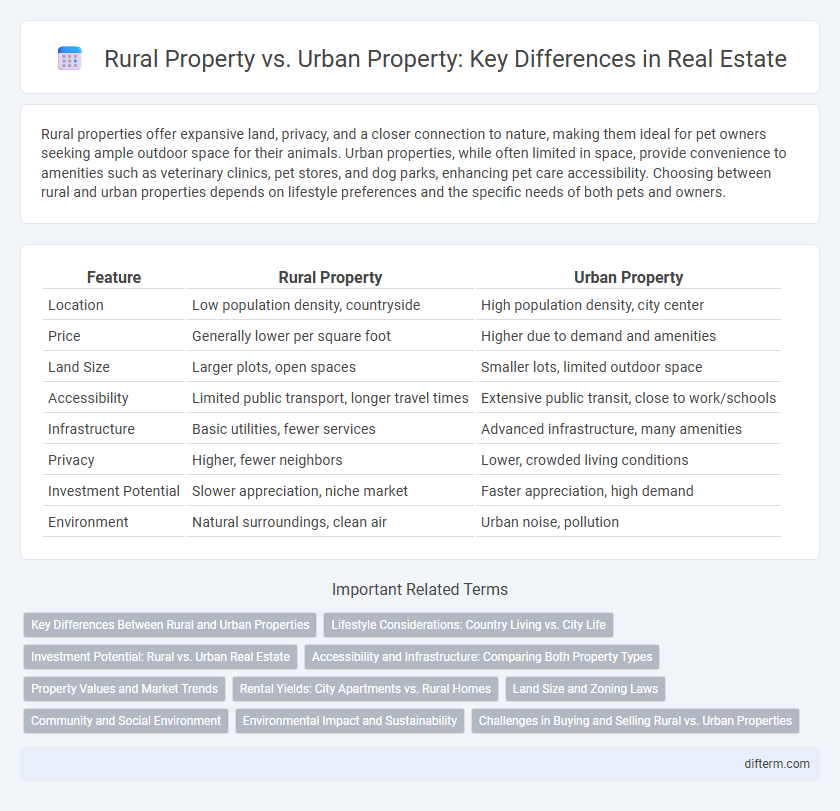Rural properties offer expansive land, privacy, and a closer connection to nature, making them ideal for pet owners seeking ample outdoor space for their animals. Urban properties, while often limited in space, provide convenience to amenities such as veterinary clinics, pet stores, and dog parks, enhancing pet care accessibility. Choosing between rural and urban properties depends on lifestyle preferences and the specific needs of both pets and owners.
Table of Comparison
| Feature | Rural Property | Urban Property |
|---|---|---|
| Location | Low population density, countryside | High population density, city center |
| Price | Generally lower per square foot | Higher due to demand and amenities |
| Land Size | Larger plots, open spaces | Smaller lots, limited outdoor space |
| Accessibility | Limited public transport, longer travel times | Extensive public transit, close to work/schools |
| Infrastructure | Basic utilities, fewer services | Advanced infrastructure, many amenities |
| Privacy | Higher, fewer neighbors | Lower, crowded living conditions |
| Investment Potential | Slower appreciation, niche market | Faster appreciation, high demand |
| Environment | Natural surroundings, clean air | Urban noise, pollution |
Key Differences Between Rural and Urban Properties
Rural properties typically offer larger land sizes, lower population density, and a closer connection to nature, while urban properties provide greater access to amenities, public transportation, and job opportunities. Property values in urban areas tend to be higher due to demand and proximity to commercial centers, whereas rural properties often emphasize agricultural potential and privacy. Infrastructure and services such as schools, hospitals, and entertainment options are more developed in urban settings, contrasting with the more limited but tranquil environment found in rural locations.
Lifestyle Considerations: Country Living vs. City Life
Rural property offers a tranquil lifestyle with expansive open spaces, lower population density, and closer proximity to nature, ideal for those seeking peace and privacy. Urban property provides convenient access to amenities, diverse cultural attractions, and robust public transportation, which suits individuals valuing connectivity and fast-paced environments. Lifestyle considerations between country living and city life significantly impact daily routines, community engagement, and overall well-being.
Investment Potential: Rural vs. Urban Real Estate
Urban real estate typically offers higher investment potential due to greater demand, faster property appreciation, and more rental income opportunities driven by population density and economic activities. Rural properties often feature lower entry costs and potential for agricultural or land development projects but generally experience slower price growth and less liquidity. Investors seeking steady cash flow and rapid asset appreciation usually prioritize urban locations, while those focused on long-term diversification and unique land uses may consider rural properties.
Accessibility and Infrastructure: Comparing Both Property Types
Rural properties often face challenges with limited accessibility and less developed infrastructure, impacting transportation, utilities, and internet connectivity. Urban properties benefit from well-established infrastructure, including public transit systems, reliable utilities, and robust communication networks, enhancing convenience and daily living. The choice between rural and urban real estate hinges on prioritizing accessibility and modern infrastructure tailored to lifestyle and investment goals.
Property Values and Market Trends
Rural property values have shown steady appreciation due to increasing demand for spacious living and agricultural potential, with market trends highlighting a rise in remote work driving interest in these areas. Urban properties continue to command higher prices thanks to proximity to amenities, employment hubs, and infrastructure development, maintaining strong liquidity and investment appeal. Real estate investors weigh the slower but stable growth in rural markets against the faster, more volatile appreciation seen in urban centers.
Rental Yields: City Apartments vs. Rural Homes
Rental yields on urban apartments generally outperform those of rural homes due to higher demand and population density in cities, leading to more consistent occupancy rates. In rural areas, rental yields tend to be lower but can offer better long-term capital growth potential, especially in regions with emerging infrastructure or tourism. Investors often weigh the stable cash flow of city apartments against the potential appreciation and unique lifestyle appeal of rural properties.
Land Size and Zoning Laws
Rural properties typically offer larger land sizes compared to urban properties, making them ideal for agricultural use or expansive personal estates. Zoning laws in rural areas are generally less restrictive, allowing for diverse land uses such as farming, forestry, or residential development with fewer limitations. Urban properties are subject to stricter zoning regulations that prioritize residential density, commercial use, and infrastructure development, often resulting in smaller lot sizes and limited flexibility.
Community and Social Environment
Rural properties often offer close-knit communities with strong social ties and a slower pace of life, fostering a sense of belonging and mutual support among residents. Urban properties provide diverse social environments with access to cultural events, social clubs, and professional networks, enriching opportunities for interaction and engagement. The choice between rural and urban real estate significantly impacts lifestyle, social connectivity, and community involvement.
Environmental Impact and Sustainability
Rural properties typically offer greater opportunities for sustainable land management practices, including organic farming and preservation of natural habitats, which contribute to biodiversity and reduced carbon footprints. Urban properties, while often associated with higher energy consumption and waste generation, benefit from concentrated infrastructure that supports public transit and energy-efficient building designs, reducing per capita environmental impact. Balancing development in rural areas with conservation efforts and promoting green building technologies in urban settings is crucial for minimizing environmental damage and enhancing overall sustainability.
Challenges in Buying and Selling Rural vs. Urban Properties
Rural property transactions often face challenges due to limited infrastructure, longer distances to amenities, and less market transparency compared to urban properties, which benefit from better accessibility and more active real estate markets. Zoning regulations and financing options can be more restrictive in rural areas, complicating the buying and selling processes. Urban properties typically experience higher demand and quicker sales cycles, while rural properties require more thorough inspections and considerations of land use and environmental factors.
rural property vs urban property Infographic

 difterm.com
difterm.com